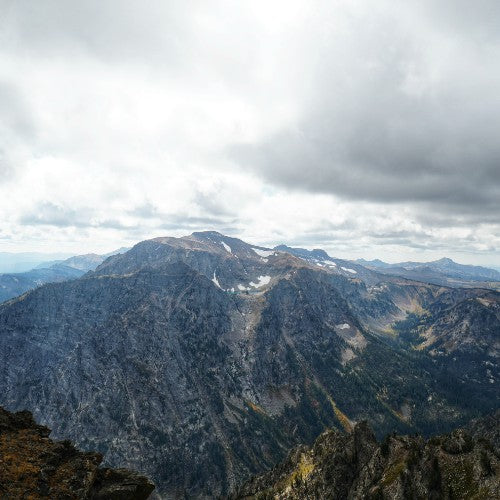

· By Amanda Stelter
Trail Reviews: Static Peak - Grand Teton National Park

Static Peak from the Divide (Photo credit: Amanda Stelter)
Trail Reviews: Static Peak – Grand Teton National Park
Distance: 16.8 miles
Elevation: 5,423 ft
If you’re looking to sneak in a summit session in the Tetons, but don’t have the equipment or technical experience to reach the top of one of the famous Teton peaks, then the hike up to Static Peak is for you. Not to be confused for an easy trip, this one is long and strenuous; however, the trail leading up to the peak requires little technical experience and no scrambling!
Surprisingly, the trailhead lies outside the park entrance stations, so you don’t need a entrance pass to get access to this trailhead. Static peak can be reached via the Death Canyon Trailhead off of Moose Junction. From Moose Junction, turn left onto Moose-Wilson Road and continue until you reach the fork leading to Death Canyon Trailhead, then turn right. The road leading to the trailhead is paved for about a mile, but then becomes a fairly rugged gravel terrain for another mile or so. Though the park recommends 4-wheel drive for this difficult portion, I made it in a high-clearance 2-wheel drive by taking it slow all the way to the trailhead.
.

Phelps Lake (Photo credit: Amanda Stelter)
There are opportunities to pull off and park leading up to the trailhead. The hike begins with a gradual incline that takes you through a pine forest and up to Valley Creek Junction where you will continue to Static Peak Divide. From here the trail will lead you directly to a scenic overlook of beautiful Phelps Lake that offers sweeping panoramic views of the forest and glistening lake below. Passing the overlook will lead you to switchbacks the take you down closer to the lake where you will reach Death Canyon Trail Junction. A sign will direct you to the left to continue to Phelps Lake, but to those wishing to reach Static Peak will continue straight for another 6.8 miles along Death Canyon Trail.
Shortly after continuing forward along Death Canyon Trail, you will begin to ascend with stunning views of the surrounding mountains making up the canyon. According to various historical sites, the canyon was formed by glacial erosion roughly 15,000 years ago that exposed rocks of the canyon estimated to be around 2.7 billion years old. Keep an eye out for wild berries growing along the trail, as well as various types of animal scat. I witnessed multiple sets of bear scat and the park strongly advises carrying bear spray that can be quickly accessed.

Views from Death Canyon Trail (PC: Amanda Stelter)
After ascending the canyon, you will reach the upper canyon where the trail levels out as you continue to Death Canyon Patrol Canyon. A sign near the cabin marks 4 miles remaining until you reach Static Peak Divide at 10,790-ft. From the cabin, the trail to the divide diverges from Death Canyon and onto Alaska Basin Trail. Due to fallen trees, the trail was partially covered; however, it wasn’t difficult to follow a fairly well-traveled path over the trees and back to the defined trail. The trail will quickly ascend as you climb one switchback after another, rising higher and higher above the canyon below and closer to the divide. The trail will take you hike up and along the side of Albright Peak where you will have clear views of the peaks across the canyon like Fossil Mountain and Mt. Bannon.
After a fairly steep ascent, you will reach the saddle between Albright Peak and static peak. Continuing from the saddle, the trail features a short series of switchbacks through an open forest, allowing the light to softly penetrate the leaves to create a serene environment. At around 8.1 miles, you will have finally made it to the Static Peak Divide.

Looking down upon Static Peak Divide from Static Peak (PC: Amanda Stelter)
The views from the divide alone are enough to make you stop in admiration before continuing the last push to the summit of Static Peak. From this viewpoint you can see the town of Jackson to the east, Death Canyon in the southwest, and the Wind River Range in the far distance. The most exciting view perhaps is that of Static Peak towering high in the distance. A short half mile trek to the peak will take you up the last 513-ft to the top. I summited Static Peak in late September and there was minimal ice along the top of the peak.
My trek to the top of Static Peak began at around 9am and was completed at the trailhead around 5:45pm. Keep in mind, I stopped for many pictures and a video chat with family from the top of the peak (very necessary). If you visit the Tetons and are looking for something challenging with great reward, then look no further than Static Peak.
